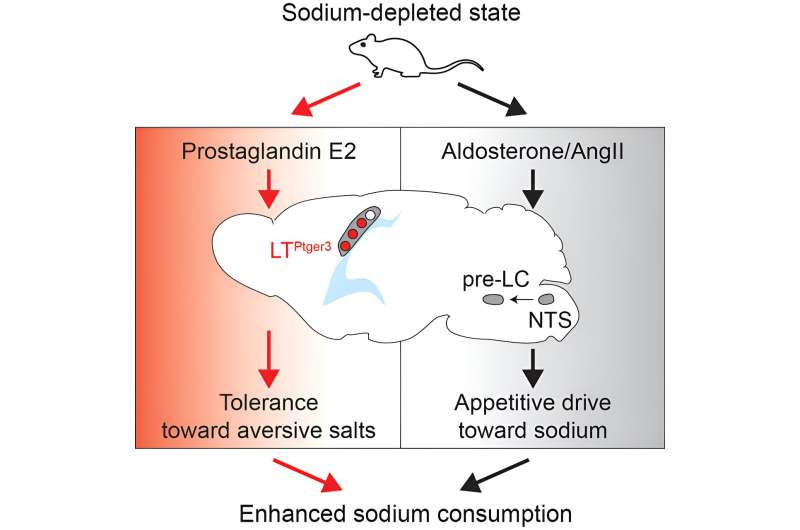This article has been reviewed according to Science X's editorial process and policies. Editors have highlighted the following attributes while ensuring the content's credibility:
fact-checked
peer-reviewed publication
trusted source
proofread
Newly discovered brain circuit controls an aversion to salty tastes

Sodium in the form of table salt helps make French fries a tasty snack and bacon a delicious indulgence, but it is also a vital nutrient for the proper functioning of our bodies, playing a role in the movement of your muscles, the signaling of your neurons, and many other important processes.
Having the right amount of sodium in your body is so crucial, in fact, that parts of your brain work hard to make sure you're getting the salt that you need. If you've ever been hit by a sudden craving for potato chips, that may have been your brain at work. On the other hand, if you're thirsty, salted snacks might sound like the last thing you need to eat. Now, new research from Caltech scientists is showing us more about how the brain regulates when the flavor of salt is yuck or yum.
"Low sodium concentration is palatable, while higher concentrations—for example, ocean water—taste disgusting," says Yuki Oka, Professor of Biology and Heritage Medical Research Institute Investigator. "But when you're really in need of salt, you don't mind the bad taste. The palatability or 'tastiness' of salt changes based on its concentration and the body's internal sodium need."
The body meticulously regulates blood sodium levels to stay within a narrow range of 135 to 145 millimolars. This is accomplished through precise control of salt consumption and retention. To keep sodium levels precisely balanced, the brain must control both attraction and aversion to salt. In 2019, researchers in the Oka lab discovered the brain circuit that drives cravings for salt in mice.
Stimulating these "salt-appetite" neurons, located at the base of the skull in a region called the hindbrain, triggered an immediate appetite for salty food. However, the mechanisms regulating an aversion to salty tastes remained unanswered.
New findings from the Oka lab reveal a distinct neural circuit in the mouse brain responsible for regulating tolerance towards the negative taste associated with sodium. These neurons are located in the forebrain, far from the salt-appetite neurons. Unlike the previously identified salt-appetite neurons, activation of the tolerance neurons does not prompt active seeking of sodium. Instead, the activity of these neurons enables mice to accept or tolerate high levels of salt that would usually be aversive to deplete sodium levels in the body efficiently.
Blocking the tolerance neurons results in mice rejecting aversive salt, even if low on sodium. The simultaneous operation of forebrain tolerance and hindbrain appetite circuits is crucial for maintaining sodium levels within the body.
The researchers found that the tolerance neurons are not directly connected to the salt appetite neurons and appear to function independently. How, then, does the body regulate the activity of the newly discovered circuits?
The new study shows that, intriguingly, the tolerance neurons have receptors for the hormone prostaglandin E2 (PGE2) on their surfaces, suggesting that their activity is modulated by this hormone circulating through the bloodstream. This is a novel revelation—prostaglandin, commonly associated with inflammation, was not previously linked to sodium intake.
According to Yameng Zhang, a graduate student in the Oka lab and the lead author of the new study, "This unexpected association between prostaglandin and sodium consumption raises important questions regarding how an inflammatory state might influence sodium intake, offering new insights into the interplay between sodium levels and the body's pro-inflammatory condition."
The findings are published in the journal Cell.
More information: Yameng Zhang et al, Parallel neural pathways control sodium consumption and taste valence, Cell (2023). DOI: 10.1016/j.cell.2023.10.020





















